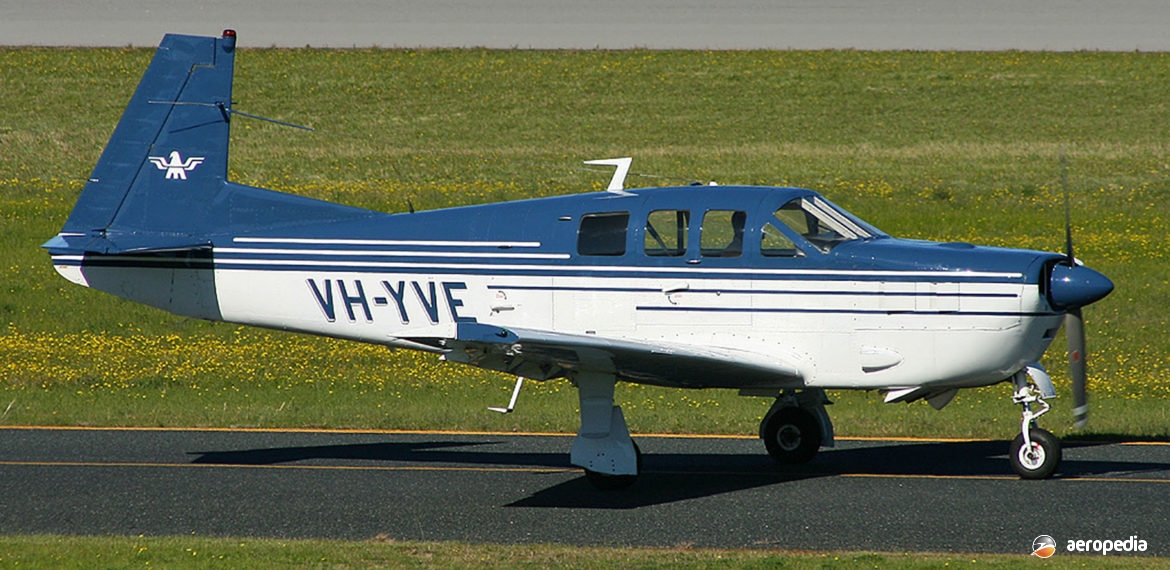Photograph:
Mooney M-22 Mustang VH-YVE (c/n 680016) at Jandakot, WA in 2016 (WA Aviation)
Country of origin:
United States of America
Description:
Five-seat light business and touring aircraft
Power Plant:
One 231 kw (310 hp) Lycoming TIO-541-A1A six-cylinder turbo-supercharged horizontally-opposed air-cooled engine
Specifications:
- Wingspan: 10.67 m (35 ft 0 in)
- Length: 8.23 m (27 ft 0 in)
- Height: 3.00 m (9 ft 10 in)
- Wing area: 15.5 m² (167 sq ft)
- Max speed: 412 km/h (256 mph)
- Cruising speed at 65% power: 344 km/h (214 mph)
- Stalling speed: 108 km/h (67 mph)
- Rate of climb: 343 m/min (1,125 ft/min)
- Service ceiling: 7,300 m (24,000 ft)
- Max range: 2,402 km (1,493 km)
- Empty weight: 1,106 kg (2,440 lb)
- Payload: 564 kg (1,243 lb)
- Loaded weight: 1,670 kg (3,680 lb)
History:
The Mooney M-22 Mustang was the first attempt by the Company to produce a single-engine pressurised aircraft and was the ultimate development of the Mooney 20 series of high-performance aircraft. It is a five-seat aircraft with a single engine, has a wider and longer fuselage, and a taller fin than the earlier models. It is a low-wing monoplane with a retractable tricycle undercarriage, the prototype (N9122L – c/n 65001) flying for the first time on 24 September 1964, the test pilot taking the aircraft to 5,639 m (18,500 ft) on this occasion. Certification was received on 26 September 1966. Only 36 examples were completed at the time the production line was closed.
Produced in small numbers, it had good performance for its time, the cabin pressurisation being provided by Garrett AiResearch giving the equivalent of 3,353 m (11,000 ft) at the operational ceiling of 7,300 m (24,000 ft). The second production aircraft (N7706M – c/n 67002) fitted with a long-range auxiliary fuel tank and, named Spirit of Texas, on 23 May 1967 was flown by Paul Rachal non-stop from New York to Paris to attend the 1967 Paris Air Show in a time of 13 hours 10 mins. This aircraft was later sold in Switzerland. At one stage it was thought the type would be of interest to the US Air Force but there was no interest from that body.
When marketed by the Company the M-22 Mustang was described as “Now step up to a new place in the sky in the world’s first pressurized single engine aircraft – the MARK 22. Occasionally an aircraft comes along that’s a world apart from its contemporaries…one that’s distinctively different in its ability to deliver a whole new realm of flight capability. Cruise at altitudes to 24,000 feet in the calm, quiet air – high above restrictive weather and turbulence without the bother of cumbersome oxygen masks. No other single engine business aircraft and very few piston-powered twins can match the MARK 22’s top speed of 256 mph at full gross weight. The MARK 22 delivers 100% turbo-supercharged power through 20,000 feet…For 1970 the Mooney MARK 22 puts you a step ahead in aircraft ownership and pilot achievement.”
Power plant was the turbocharged Lycoming TIO-541-A1A unit driving a Hartzell two-blade propeller. Entry to the cabin was via a single wide door on the starboard side with an upward-opening articulated fold-up hatch designed to permit a stretcher to be loaded. Testing revealed the aircraft climbed better than was anticipated and reached 6,096 m (20,000 ft) in 20 minutes. Three airframes (c/ns 65002, 65003 and 65004) were static test frames. However, during the time of the production of the type Mooney suffered some financial problems and was taken over by Butler Aviation which had acquired the Smith Aerostar, the Company becoming Aerostar Aircraft Corp. Towards the end of its production run the M-22 was being sold at less than the production cost. Some 20-odd airframes are known to survive with quite a few airworthy.
The first and only example of the Mustang in Australia was VH-YVE (c/n 680016 – ex N7719M) registered on 31 January 2002, based and operated in Western Australia.

